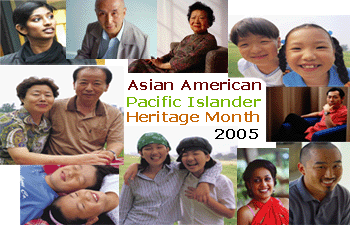|
Archived
June, 2007 |
 |
Highlights in Minority Health
May, 2005

| MAY IS ASIAN
AMERICAN AND PACIFIC ISLANDER HERITAGE MONTH |
| During the observance of Asian American
and Pacific Islander (AAPI) Heritage Month, we celebrate the
cultural traditions, ancestry, native languages, and unique
experiences represented among more than 47 ethnic groups from Asia
and the Pacific Islands (speaking over 100 languages) who live in
the United States. We also recognize millions of AAPIs whose love of
family, hard work, and community has helped unite us as a people and
sustain us as a Nation. AAPIs represent one of the fastest-growing
and most diverse populations in the United States. |
| According to 2003 President’s Advisory
Commission on Asian Americans and Pacific Islanders (AAPIs), Report
to the President and the Nation, AAPIs encompass many populations
that make critically important contributions to American life. AAPI
communities often are stereotyped as a “model minority” that
generally enjoys superior health status. In reality, AAPI
individuals and families experience genuine health disparities in
cancer screening, diabetes, and infectious diseases, among others.
It is important to recognize that AAPI subpopulations have distinct
languages, cultures, histories, and politico-economic environments. |
| |
| Asian Americans |
| Asian Americans represent both extremes of
socioeconomic and health indices: while 11.8% of Asian Americans
lived in poverty in 2003, Asian American women have the highest
life expectancy of any other group. While Asian Americans have the
highest proportion of college graduates of any race or ethnic group,
they suffer disproportionately from certain types of cancer,
infectious diseases, and other chronic diseases. Factors
contributing to poor health outcomes for Asian Americans include
language and cultural barriers, stigma associated with certain
conditions, and lack of health insurance. Asian American elders are
more likely live in poverty and experience language and cultural
barriers that make them less likely to receive social services and
medical care. |
| |
| Native Hawaiians
and Other Pacific Islanders (NHOPIs) |
| The U.S.-associated Pacific Island
Jurisdictions comprise three flag territories: American Samoa, the
Commonwealth of the Northern Mariana Islands (CNMI), Guam, and three
Feely Associated States: the Federated States of Micronesia (FSM),
the Republic of the Marshall Islands (RMI), and the Republic of
Palau. They are U.S. territories made up of hundreds of small
islands and atolls spread across about 5 million square miles of
ocean—nearly half the size of the United States—with a total
population of 469,356 (1999 and 2000 estimates). Native Hawaiians
and Other Pacific Islanders (NHOPIs) generally experience poorer
health than the American population as a whole; major causes of
premature death among NHOPIs are obesity, cardiovascular diseases,
cancer, and diabetes. |
| |
| EXAMPLES OF
IMPORTANT DISPARITIES EXPERIENCED BY ASIAN AMERICANS
/ NATIVE HAWAIIAN & OTHER PACIFIC ISLANDERS |
| |
 |
While the rate (per 100,000 population) of acute
hepatitis B (HBV) among AAPIs has been decreasing, the reported rate
in 2001 was more than twice as high among Asian Americans and
Pacific Islanders (3.0) as among white Americans (1.3). |
| |
 |
The tuberculosis rate (cases per 100,000) in 2004 was
8.4 times higher in the U.S. Pacific Islands (41.4) than in the
mainland U.S. (4.9). |
| |
 |
In 2002, the AIDS rate (cases per 100,000) among AAPIs
was 4.0. During 2003, 497 new AIDS cases were reported among AAPIs,
an increase of 9.9 percent over 2002 and of 34.7 percent over the
1999 level. |
| |
 |
The incidence rates for liver and stomach cancer were
substantially higher among AAPIs than among other races in
1996-2000. |
|
Incidence Rates per 100,000 Population, US, 1996-2000
| |
African
American |
American
Indian and Alaska Native |
Asian American & Pacific Islander |
Hispanic/
Latino |
White |
|
Stomach
Cancer |
14.0 |
11.0 |
17.3 |
13.3 |
7.7 |
|
Liver
Cancer |
6.9 |
5.9 |
13.8 |
9.1 |
4.8 |
Source: National
Cancer Institute,
http://www.cancer.gov/cancertopics/factsheet/cancerhealthdisparities |
| |
 |
According to the American Cancer Society, in 2000
Asian American women (ages 18+) were least likely to have had a Pap
test in the preceding three years (68.2%) compared with other
racial/ethnic women (White: 83.9%, African American: 85.5%,
Hispanic/Latino: 77.9%, American Indian/Alaska Native: 78.4%). |
| |
 |
The infant mortality rate (deaths per 1,000 live
births) for Native Hawaiians in 2002 was 9.6, higher than the rate
for all AAPIs combined (4.8), and for all populations (7.0). |
| |
 |
The 5-year relative survival rate for all cancers for
Native Hawaiians is 47%, compared with 57% for whites and 55% for
all races. |
| |
 |
In 200-2002, Native Hawaiians in Hawaii were 2.3 times
more likely to be diagnosed with diabetes than non-Hispanic white
residents of Hawaii (Hawaii overall, 5.6%; Native Hawaiian, 7.9%;
whites, 3.4%). |
| |
| FOR MORE INFORMATION |
| |
Asian American Populations |
| |
Native Hawaiian and Other Pacific Islander Populations |
| |
President’s Advisory Commission on Asian Americans and Pacific
Islanders (AAPIs), 2003 Report to the President and the Nation |
| |
White House Proclamation: Asian/Pacific American Heritage Month 2005 |
|
|


